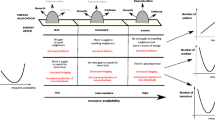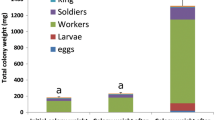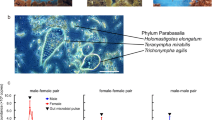Abstract
Termites feed on a carbon-rich but nitrogen-poor diet and evolved efficient nitrogen conservation strategies. It was previously suggested that during time of low access to resources (i.e., starvation), subterranean termites (Rhinotermitidae) colonies would adopt an energy conservation strategy by cannibalizing soldiers, a dependent caste. However, such hypothesis was tested with relatively small groups of foragers, which may not have reflected how resources are reallocated in whole colonies when food (carbon) is scarce. The current study subjected 2-year-old colonies (≈ 3000 termites with all castes and instars) to starvation, in order to reexamine if cannibalism is part of an active energy conservation strategy. Within 12 days of starvation, eggs and larvae were all cannibalized, followed by young workers. Soldiers then died marginally faster than old workers. By 22 days, cannibalism was no longer observed, and the king and queen were among the last individuals to die. Termites that engaged in the process of ecdysis with no energetic resources, failed to molt, died in the process, and the subsequent cannibalism was a passive mortality-driven process. Therefore, cannibalism was primarily the result of the inherent termite behavior for recycling nitrogen resources. The hemimetabolous developmental pathway, the difference of timing in the molting cycle of termite instars and the relatively rapid exhaustion of soldiers, indirectly determined the sequence of starvation-induced mortality and subsequent cannibalism. Although termites have evolved efficient nitrogen conservation strategies, they have not evolved an efficient carbon conservation strategy, which is essentially limited to keeping the primary reproductives alive as long as possible.





Similar content being viewed by others
References
Belitz LA, Waller DA (1998) Effect of temperature and termite starvation on phagocytosis by protozoan symbionts of the eastern subterranean termite Reticulitermes flavipes Kollar. Microb Ecol 36:175–180
Brent CS, Traniello JF (2002) Effect of enhanced dietary nitrogen on reproductive maturation of the termite Zootermopsis angusticollis (Isoptera: Termopsidae). Environ Entomol 31:313–318
Breznak JA, Brune A (1994) Role of microorganisms in the digestion of lignocellulose by termites. Annu Rev Entomol 39:453–487
Brune A, Ohkuma M (2010) Role of the termite gut microbiota in symbiotic digestion. Biology of termites: a modern synthesis. Springer, Dordrecht, pp 439–475
Buchli HR (1958) Recherche sur la fondation et le développement des nouvelles colonies chez le ermite lucifuge (Reticulitermes lucifugus (Rossi)). Physol Comp Oecol 2:145–160
Chong A, Yap HH, Chong NL Lee CY (2002) Effects of starvation on nutrient distribution in the Pharaoh ant, Monomorium pharaonis (L.) (Hymonoptera: Formicidae) workers and various larval stages. In: Jones SC, Zhai J, Robinson WH (eds) Proceedings of the 4th international conference on urban pests. Pocahontas Press, Blacksburg, Virginia, pp 121–128
Chouvenc T (2018) Comparative impact of chitin synthesis inhibitor baits and non-repellent liquid termiticides on subterranean termite colonies over foraging distances: colony elimination versus localized termite exclusion. J Econ Entomol 111:2317–2328
Chouvenc T (2019) The relative importance of queen and king initial weights in termite colony foundation success. Insect Soc 66:177–184
Chouvenc T, Foley JR IV (2018) Coptotermes gestroi (Wasmann)(Blattodea [Isoptera]: Rhinotermitidae), a threat to the southeastern Florida urban tree canopy. Fla Entomol 101:79–91
Chouvenc T, Su NY (2010) Apparent synergy among defense mechanisms in subterranean termites (Rhinotermitidae) against epizootic events: limits and potential for biological control. J Econ Entomol 103:1327–1337
Chouvenc T, Su NY (2012) When subterranean termites challenge the rules of fungal epizootics. PLoS One 7:e34484
Chouvenc T, Su NY (2014) Colony age-dependent pathway in caste development of Coptotermes formosanus Shiraki. Insect Soc 61:171–182
Chouvenc T, Su NY (2017) Subterranean termites feeding on CSI baits for a short duration still results in colony elimination. J Econ Entomol 110:2534–2538
Chouvenc T, Su NY, Elliott ML (2008) Interaction between the subterranean termite Reticulitermes flavipes (Isoptera: Rhinotermitidae) and the entomopathogenic fungus Metarhizium anisopliae in foraging arenas. J Econ Entomol 101:885–893
Chouvenc T, Su NY, Robert A (2009) Inhibition of Metarhizium anisopliae in the alimentary tract of the eastern subterranean termite Reticulitermes flavipes. J Invertebr Pathol 101:130–136
Chouvenc T, Bardunias P, Li HF, Elliott ML, Su NY (2011) Planar arenas for use in laboratory bioassay studies of subterranean termites (Rhinotermitidae). Fla Entomol 94:817–827
Chouvenc T, Robert A, Sémon E, Bordereau C (2012) Burial behaviour by dealates of the termite Pseudacanthotermes spiniger (Termitidae, Macrotermitinae) induced by chemical signals from termite corpses. Insect Soc 59:119–125
Chouvenc T, Basille M, Su NY (2015a) The production of soldiers and the maintenance of caste proportions delay the growth of termite incipient colonies. Insect Soc 62:23–29
Chouvenc T, Mullins AJ, Su NY (2015b) Rare production of nymphs in an Asian subterranean termite (Isoptera: Rhinotermitidae) incipient colony. Fla Entomol 98:972–974
Chouvenc T, Scheffrahn RH, Su NY (2016) Establishment and spread of two invasive subterranean termite species (Coptotermes formosanus and C. gestroi; Isoptera: Rhinotermitidae) in metropolitan southeastern Florida (1990–2015). Fla Entomol 99:187–191
Cleveland LR (1923) Symbiosis between termites and their intestinal protozoa. Proc Nat Acad Sci USA 9:424–428
Cleveland LR (1925) The effects of oxygenation and starvation on the symbiosis between the termite, Termopsis, and its intestinal flagellates. Biol Bull 48:309–326
Curtis AD, Waller DA (1997) Variation in rates of nitrogen fixation in termites: response to dietary nitrogen in the field and laboratory. Physiol Entomol 22:303–309
Davis HE, Meconcelli S, Radek R, McMahon DP (2018) Termites shape their collective behavioural response based on stage of infection. Sci Rep 8:1–10
Du H, Chouvenc T, Osbrink WLA, Su NY (2016) Social interactions in the central nest of Coptotermes formosanus juvenile colonies. Insect Soc 63:279–290
Duarte S, Duarte M, Borges PA, Nunes L (2017) Dietary-driven variation effects on the symbiotic flagellate protist communities of the subterranean termite Reticulitermes grassei Clément. J Appl Entomol 141:300–307
Emerson AE (1939) Social coordination and the superorganism. Am Midl Nat 21:182–209
Fox J, Weisberg S (2011) Cox proportional-hazards regression for survival data in R, second edition. https://socialsciences.mcmaster.ca/jfox/Books/Companion-2E/appendix/Appendix-Cox-Regression.pdf. Accessed Jun 2019
Gulmahamad H (2002) Survival strategy of a western drywood termite colony, Incisitermes minor, (Isoptera: Kalotermitidae) established in a limited food source. Sociobiol 40:595–604
Haifig I, Lima JT, Janei V, Costa-Leonardo AM (2018) Effects of group size and starvation on survival of the Asian subterranean termite Coptotermes gestroi (Isoptera: Rhinotermitidae). Austral Entomol 57:279–284
Hedlund JC, Henderson G (1999) Effect of available food size on search tunnel formation by the Formosan subterranean termite (Isoptera: Rhinotermitidae). J Econ Entomol 92:610–616
Higa SY (1981) Flight, colony foundation and development of the gonads of the primary reproductives of the Formosans subterranean termites, Coptotermes formosanus Shiraki. Ph.D. dissertation, University of Hawaii, Honolulu
Higashi M, Abe T, Burns TP (1992) Carbon–nitrogen balance and termite ecology. Proc R Soc Lond B 249:303–308
Howard DF, Tschinkel WR (1980) The effect of colony size and starvation on food flow in the fire ant, Solenopsis invicta (Hymenoptera: Formicidae). Behav Ecol Sociobiol 7:293–300
Hu XP, Song D, Gao X (2011) Biological changes in the Eastern subterranean termite, Reticulitermes flavipes (Isoptera, Rhinotermitidae) and its protozoa profile following starvation. Insect Soc 58:39–45
Hunt JH, Nalepa CA (1994) Nourishment and evolution in insect societies. Westview Press, Boulder, p 449
Josens RB, Roces F (2000) Foraging in the ant Camponotus mus: nectar-intake rate and crop filling depend on colony starvation. J Insect Physiol 46:1103–1110
Kakkar G, Su NY (2018) Molting drives mortality in foraging populations of Formosan subterranean termites (Isoptera: Rhinotermitidae) baited with a chitin synthesis inhibitor, noviflumuron. Pest Manag Sci 74:219–224
Kakkar G, Chouvenc T, Osbrink W, Su NY (2016) Temporal assessment of molting in workers of Formosan subterranean termites (Isoptera: Rhinotermitidae). J Econ Entomol 109:2175–2181
Kakkar G, Osbrink W, Mullins A, Su NY (2017) Molting site fidelity in workers of Formosan subterranean termites (Isoptera: Rhinotermitidae). J Econ Entomol 110:2512–2517
Korb J, Lenz M (2004) Reproductive decision-making in the termite, Cryptotermes secundus (Kalotermitidae), under variable food conditions. Behav Ecol 15:390–395
Lo Pinto M, Agrò A (2019) Effects of starvation on survival, cannibalism, body mass, and intestinal protozoan profile in the subterranean termite Reticulitermes lucifugus. Insect Soc. https://doi.org/10.1007/s00040-019-00711-1
Machida M, Kitade O, Miura T, Matsumoto T (2001) Nitrogen recycling through proctodeal trophallaxis in the Japanese damp-wood termite Hodotermopsis japonica (Isoptera, Termopsidae). Insect Soc 48:52–56
McMahan EA (1963) A study of termite feeding relationships, using radioisotopes. Ann Entomol Soc Am 56:74–82
Modlmeier AP, Foitzik S, Scharf I (2013) Starvation endurance in the ant Temnothorax nylanderi depends on group size, body size and access to larvae. Physiol Entomol 38:89–94
Moore BP (1969) Biochemical studies in termites. In: Krishna K, Weesner FM (eds) Biology of termites, vol 1. pp 407–432
Mullins A, Su NY (2018) Parental nitrogen transfer and apparent absence of N2 fixation during colony foundation in Coptotermes formosanus Shiraki. Insects 9:37
Nakajima S, Shimizu K, Nakajima Y (1963) Analytical studies on the vitality of colonies of the Formosan termite. Coptotermes formosanus, II. Seasonal fluctuations on the external characters of the workers, the ratio of caste-number and carbon dioxide in the nest of a colony. Miyazaki Univ Fac Agric Bull 9:222–227
Nalepa CA (1994) Nourishment and the origin of termite eusociality. In: Hunt JH, Nalepa CA (eds) Nourishment and evolution in insect societies. Westview Press, Boulder, pp 57–104
Noda S, Ohkuma M, Kudo T (2002) Nitrogen fixation genes expressed in the symbiotic microbial community in the gut of the termite Coptotermes formosanus. Microb Environ 17:139–143
Osbrink WLA, Cornelius ML, Showler AT (2015) Bionomics and formation of “Bonsai” colonies with long-term rearing of Coptotermes formosanus (Isoptera: Rhinotermitidae). J Econ Entomol 109:770–778
Prestwich GD, Bentley BL, Carpenter EJ (1980) Nitrogen sources for neotropical nasute termites: fixation and selective foraging. Oecologia 46:397–401
R Core Team (2018) R: a language and environment for statistical computing. R Foundation for Statistical Computing, Vianna, p 2018
Raina AK, Park YI, Lax A (2004) Defaunation leads to cannibalism in primary reproductives of the Formosan subterranean termite, Coptotermes formosanus (Isoptera: Rhinotermitidae). Ann Entomol Soc Am 97:753–756
Raina A, Park YI, Gelman D (2008) Molting in workers of the Formosan subterranean termite Coptotermes formosanus. J Insect Physiol 54:155–161
Reinhard J, Hertel H, Kaib M (1997) Systematic search for food in the subterranean termite Reticulitermes santonensis De Feytaud (Isoptera, Rhinotermitidae). Insect Soc 44:147–158
Rosengaus RB, Traniello JF (2001) Disease susceptibility and the adaptive nature of colony demography in the dampwood termite Zootermopsis angusticollis. Behav Ecol Sociobiol 50:546–556
Rüppell O, Kirkman RW (2005) Extraordinary starvation resistance in Temnothorax rugatulus (Hymenoptera, Formicidae) colonies: demography and adaptive behavior. Insect Soc 52:282–290
Scheffrahn RH, Su N-Y (2005) Distribution of the termite genus Coptotermes (Isoptera: Rhinotermitidae) in Florida. Fla Entomol 88:201–203
Shellman-Reeve JS (1990) Dynamics of biparental care in the dampwood termite, Zootermopsis nevadensis (Hagen): response to nitrogen availability. Behav Ecol Sociobiol 26:389–397
Shimizu K (1962) Analytical studies on the vitality of colonies of the Formosan subterranean termite, Coptotermes formosanus Shiraki. I. Analysis of the strength and vitality. Miyazaki Univ Fac Agric Bull 8:108–110
Smythe RV, Mauldin JK (1972) Soldier differentiation, survival, and wood consumption by normally and abnormally faunated workers of the Formosan termite, Coptotermes formosanus. Ann Entomol Soc Am 65:1001–1004
Song D, Hu XP, Su NY (2006) Survivorship, cannibalism, body weight loss, necrophagy, and entombment in laboratory groups of the Formosan subterranean termite, Coptotermes formosanus under starvation (Isoptera: Rhinotermitidae). Sociobiology 47:27–39
Su NY, La Fage JP (1986) Effects of starvation on survival and maintenance of soldier proportion in laboratory groups of the Formosan subterranean termite, Coptotermes formosanus (Isoptera: Rhinotermitidae). Ann Entomol Soc Am 79:312–316
Su NY, La Fage JP (1987) Initiation of worker-soldier trophallaxis by the Formosan subterranean termite (Isoptera: Rhinotermitidae). Insect Soc 34:229–235
Su N-Y, Puche H (2003) Tunneling activity of subterranean termites (Isoptera: Rhinotermitidae) in sand with moisture gradients. J Econ Entomol 96:88–93
Su NY, Osbrink WLA, Kakkar G, Mullins A, Chouvenc T (2017) Foraging distance and population size of juvenile colonies of the Formosan subterranean termite (Isoptera: Rhinotermitidae) in laboratory extended arenas. J Econ Entomol 110:1728–1735
Sun Q, Zhou X (2013) Corpse management in social insects. Int J Biol Sci 9:313–321
Traniello JF, Leuthold RH (2000) Behavior and ecology of foraging in termites. Termites: evolution, sociality, symbioses, ecology. Springer, Dordrecht, pp 141–168
Waller DA, La Fage JP (1987) Food quality and foraging response by the subterranean termite Coptotermes formosanus Shiraki (Isoptera: Rhinotermitidae). Bull Entomol Res 77:417–424
Wang Y, Campbell JB, Kaftanoglu O, Page RE, Amdam GV, Harrison JF (2016a) Larval starvation improves metabolic response to adult starvation in honey bees (Apis mellifera L.). J Exp Biol 219:960–968
Wang Y, Kaftanoglu O, Brent CS, Page RE, Amdam GV (2016b) Starvation stress during larval development facilitates an adaptive response in adult worker honey bees (Apis mellifera L.). J Exp Biol 219:949–959
Xing L, Chouvenc T, Su NY (2013) Molting process in the Formosan subterranean termite (Isoptera: Rhinotermitidae). Ann Entomol Soc Am 106:619–625
Xing L, Chouvenc T, Su NY (2014) Behavioral and histological changes in the Formosan subterranean termite (Isoptera: Rhinotermitidae) induced by the chitin synthesis inhibitor noviflumuron. J Econ Entomol 107:741–747
Zukowski J, Su NY (2017) Survival of termites (Isoptera) exposed to various levels of relative humidity (RH) and water availability, and their RH preferences. Fla Entomol 100:532–539
Acknowledgements
Thanks to Zachary Kaplan, Ronald Pepin, Reynaldo Moscat and Alvin Puzio for technical assistance, Aaron Mullins, Nan-Yao Su and two anonymous reviewers for providing constructive comments on early versions of this manuscript. This study was supported in part by a grant from USDA-ARS under the Grant agreement no. 58-6435-8-276, by NSF-DEB Grant agreement no. 1754083, and by a research opportunity fund of the University of Florida under the Grant agreement no. 00094648.
Author information
Authors and Affiliations
Corresponding author
Rights and permissions
About this article
Cite this article
Chouvenc, T. Limited survival strategy in starving subterranean termite colonies. Insect. Soc. 67, 71–82 (2020). https://doi.org/10.1007/s00040-019-00729-5
Received:
Revised:
Accepted:
Published:
Issue Date:
DOI: https://doi.org/10.1007/s00040-019-00729-5




